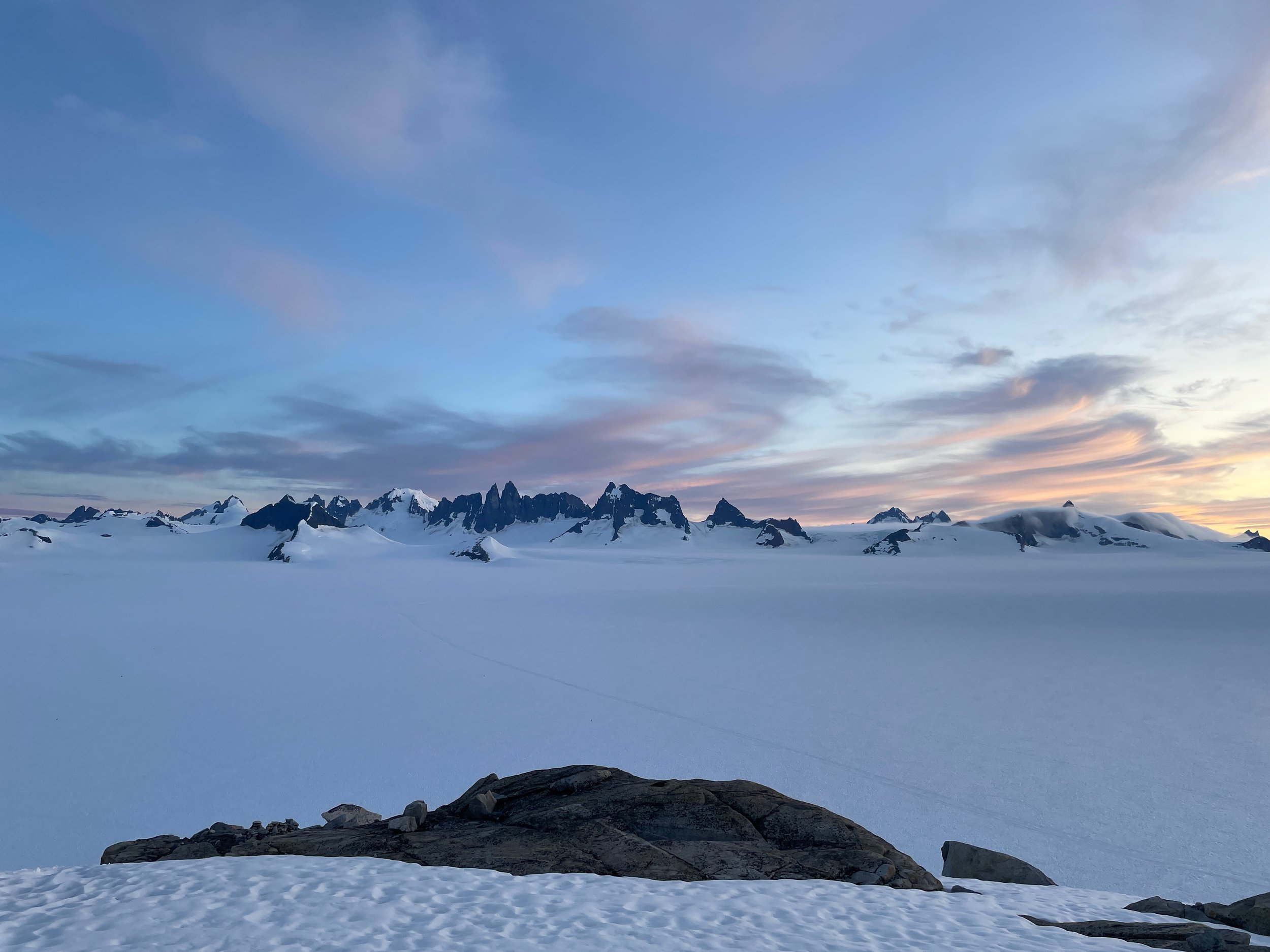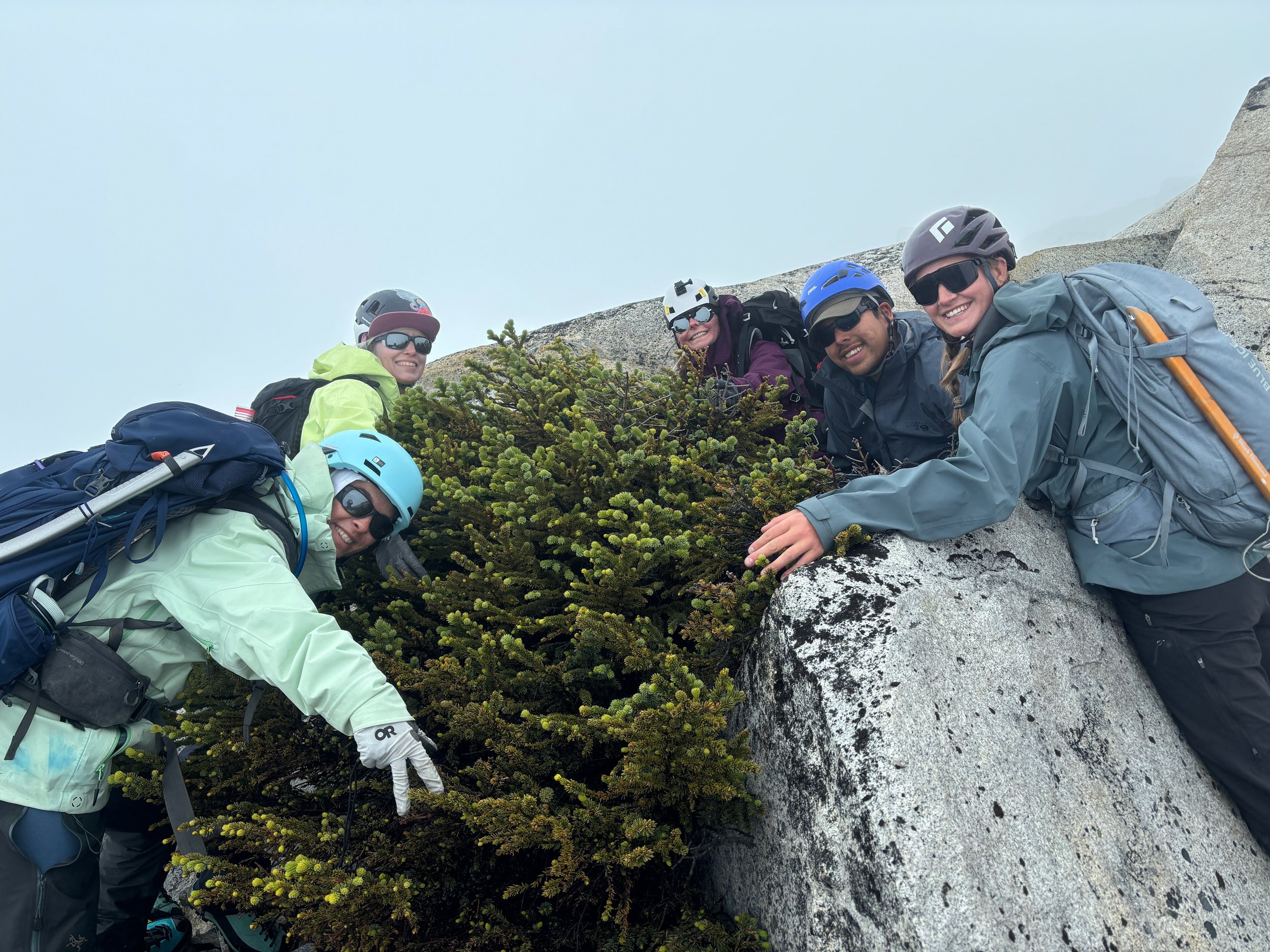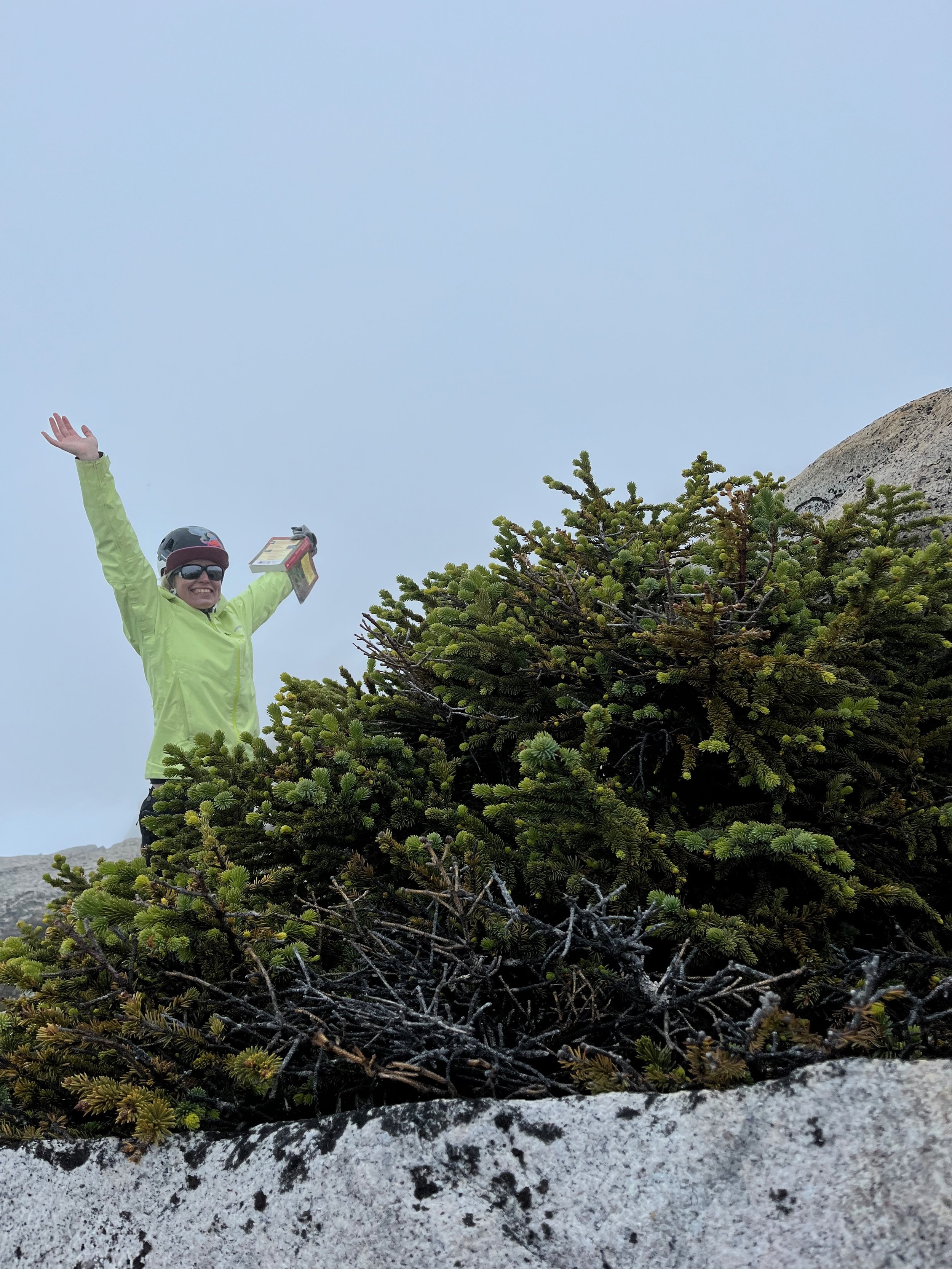In Search
Creative Non-fiction & Photography by Elizabeth Weinberg
Published in Buckman journal: preserve & decay
Months before I went to the ice, I learned about the tree. It was mentioned almost in passing by a friend who had been there before: among the glaciers I would be visiting rose a nunatak, a lonely peak within the white expanse of deep freeze. And on that nunatak, there was a single, dogged tree, clinging to this slope of granite, burrowing its roots into scant soil and making a life for itself.
I couldn’t help but picture a lone pine or spruce, tall and perfectly triangular, proud and towering amidst the wind and weather. An impossible tree, a beacon, the only life withstanding where nothing else would grow.
In addition to this tree, the Taku B nunatak holds Camp 10, a field site established in the 1940s for what became the Juneau Icefield Research Program. Each year, the program brings a new cohort of students up to the Juneau Icefield, which is a conglomeration of hundreds of glaciers straddling the border between the U.S. and Canada. The students—ranging from high school seniors to PhD candidates—spend the summer taking ice, rock, and water samples, digging snow pits, designing research projects, skiing across glaciers, and learning how to safely traverse the terrain. And faculty, like me, join for a few weeks at a time.
At Camp 10, plywood and aluminum siding buildings perch above the vast Taku Glacier, a small ramshackle village above a broad, endless stretch of ice. For two weeks, the camp was my home, shared with thirty or so students and fifteen other faculty and staff members.
The students were here to learn field techniques. Some were budding glaciologists, interested in how ice changes or the impacts diminishing glaciers have downstream. Some were geologists, curious about the processes that made the rock formations beneath the icefield, while others were interested in the biotic communities, the lichens on the nunataks or the algae growing atop snow. Still others—probably most of the students—were undecided, intrigued by everything and using the program to understand all they could possibly study. Together, they learned how to excavate the glacier to track the previous winter’s snowfall; to measure density and change in the icefield; to sample melt ponds and glacial rivers; to read the rock formations and chisel samples to send back to labs.
And while the students were there to learn, they were also actively contributing to science. The Taku has one of the longest, most consistent data sets in North America, its only competition being the nearby Lemon Creek Glacier. That’s due entirely to the program: every single year since the 40s, even during the COVID-19 pandemic, students and working scientists have come to these glaciers to measure how much they have grown or retreated, digging sampling pits at the same locations for decades and using instrumentation to ground truth their data. Students and faculty have logged glacier elevation, tracked meteorological trends, and contributed hundreds of publications to the scientific record.
Each summer the students get to know the glaciers intimately. Like ice across the globe, the Juneau Icefield is shrinking. The Mendenhall no longer reaches the lake it feeds near Juneau; instead, its terminus perches on the rocks above. The Gilkey, a long river of ice that carved a deep valley, is deflating and melting away. For decades, the Taku—at nearly a mile deep, one of the thickest alpine glaciers in the world—held out, actually growing when so many others were recoiling from our changing climate. But since 2019, it has been pulling back, the winter snowfall no match for the warming air. It is thinning out, and its tongue no longer extends quite so far into the Taku River down below.
The other faculty with me at Camp 10 were researchers, a mix of geologists, glaciologists and paleoglaciologists, biogeochemists, and engineers taking a few weeks out of their summer to share their expertise with the students. They were here on the icefield to teach them to understand the glaciers, to scientifically contextualize the ice within our changing climate.
I, on the other hand, am no scientist: I write about science, work with scientists every day, but before I came to the ice, I couldn’t have even begun to tell you how to sample it, nor how it flowed and why. No: I was there to teach the students how to talk about what they found. To use narrative and language to reconcile their science with the ecological and human crises at hand.
I expected two weeks of nothing but snow and ice and bare rock. We took a helicopter out of Juneau, and I watched as the lush mountainsides of the Tongass Rainforest, the dappled greens of Sitka spruce and western hemlock abruptly yielded to the endless white and blue of the ice. I’d been nervous about the flight, but up in the air I forgot to be afraid: from the high vantage of the helicopter I could see lofty mountain peaks, glistening snowfields, the dappled texture of glacial crevasses, the gemstone blue of surface lakes. I was giddy with awe.
I’ve spent plenty of time among mountains, hiking and backpacking and rock climbing and skiing; the backcountry isn’t new to me, and neither is snow. But I had never been somewhere so obviously remote and largely uninhabited. Beyond the researchers who visit the icefield each summer and the occasional mountaineer, no humans live on the icefield, though communities like Juneau and Atlin abut the glaciers’ outflows, and the glaciers are culturally important to many of the Tlingit communities who have lived in the area since time immemorial. Few animals live there, either: nunataks are home to marmots and mice and sometimes wolverines, but in the middle of a glacier the most you’re likely to find is the body of a bird or butterfly that was blown off course during migration. A glacier isn’t like a typical alpine mountain valley, with a winding river full of fish and alder trees for animals to hide themselves among and hardy berry plants to eat. No—it’s just ice. Miles and miles of ice. The Taku alone is three miles across and almost 35 miles wide. From above it looks perfectly flat, a never-ending expanse of white.
It was inconceivably beautiful, and utterly alien.
But as we touched down these two worlds merged. We were surrounded by snow and ice, yes, but the rocks were covered in technicolor moss and lichen. The heather was in full bloom, tiny white and pink and neon green bellflowers blossoming in the sandy dirt. My field guide told me these wizened plants could live for twenty years, and I laid by them on my belly to try to understand how something so small and delicate could also be so old.
I was the happiest I’d been in ages, overjoyed to be among so many brilliant, curious people, to be learning from all of them, in a place so strangely bewitching. Every moment brought something new. The fishbowl feeling of sitting in the middle of the glacier, ice in every direction and craggy mountains along all the horizon lines. The swish of skis over summer-warmed snow, the crunch of shovels digging a pit to understand the year’s snowfall, the croon of Fleetwood Mac from a tinny speaker and the laughter of the digging students. The cool blue light coming through the layers of the snow once the pit was dug. The clink of the rock hammer into granite, the lecture on how sunlight hitting the rocks alters them, changing their chemistry to mark exactly when the glacier melted away. The sunburn and the newly-learned kickturns on skis and the icy-clean taste of snow scooped right off the Taku surface.
I was in love: with the ice, with the glacier, with the mountain. Most of all, with the students: their questions, their knowledge, their jokes, their dance parties, their desire and willingness to do more, to learn more, to understand the rocks and the ice and everything in between.
One by one, many of the students came to me, asking in quiet resignation or in heavy frustration, how to bear the grief that comes with studying and loving a dying place. If they had lived a hundred years earlier, they’d be tracking the changes of the icefield that happen separate from us, its long inhalations and exhalations, its incremental advance and retreat. A glacier can ebb and flow for thousands, or hundreds of thousands, of years. They’d have been studying something that would long outlast them, glaciers that hardly noticed human time.
But now, as students of the Taku and its kin, they become students of endings. We humans are steadily melting glaciers around the world with our carbon emissions and warming atmosphere. The Juneau Icefield is no exception. Between 2010 and 2020, it lost five percent of its entire volume, and this sea of glaciers is fragmenting, leaving more bare rock in its midst. Even if we stop burning fossil fuels tomorrow, the glaciers are near a tipping point, and may not be able to regrow anytime soon.
How can you devote your life to studying a place, knowing it will end? We talked about embracing grief, and sharing it, about noticing the ways the glaciers are fading and allowing ourselves to feel and talk about our pain’s raw edges and dull, heavy hammerings. We talked about the joy in curiosity, in the exertion of a hard ski or the sparkle of a perfect vein of quartz, in the reflection of the sun off the snow or the unreal blue of an icefall.
But mostly, I had no good answers. All I could do was take them to find the tree.
On a drizzly, cloudy morning, six of us put on our hiking boots and set off up the mountain. I’d made it a lesson in wayfinding: we knew the tree was nearby, but no one could remember exactly where. We had a photo taken the year before of the descent back to camp, but decided not to look at an additional image of the tree itself. We wanted that to be a surprise, to test our expectations of this alpine tree against its reality. So the students would only have the view—the angle of the camp buildings, the shape and forms of the rocks—to know where we were, and when we were close.
The cloud ceiling was low and clinging to the nunatak. As we climbed, Camp 10 disappeared, swallowed by the fog. So we walked for a few minutes, looked at the photos, looked at the rocks: did that one’s stripe of darker material match the one in our photo? Could we see the perfectly cube-shaped stone? Did that boulder slant at the right angle, or did we need to move further to the left?
While they planned our route I gawked at the greenery, pulling out my field guide and letting it get dewy with fog. As we moved further from camp, the heather ceded ground: dwarf alpine blueberry elbowed its way into cracks within the stones, while tiny alpine azaleas—their leaves bright green and leathery, their petals vivid pink—grew in thick mats. Lichens stretched in beards and crusts across the rocks, some feathery and hairy, others in prongs like the tiniest reindeer antlers. And then there was lupine, my favorite flower, droplets of rain collecting in its furry leaves, its purple pea flowers beckoning.
We hiked, paused, compared the rocks around us to the photo. Hiked again, up slope this time. For an hour, we moved through this cycle of walking, pulling out the photo, and changing our direction, until we realized we were too high up the mountain and retreated down the slope. We were getting rained on, growing damp, but still euphoric with the search. There was so much to see up here! And we knew we would find it. We were determined.
Photo by: Aaron Brillhart
Photo by: Carly Hayward
We’d walked a great loop along the nunatak when one of the students began moving faster, carving a line along the crags. She’d seen it, and the rest of us trailed her, trying to spot what she had noticed.
And then—Tree!
We whooped and hollered, posed for pictures. We did a group tree hug, laughing and wincing as its needles jabbed our faces. It felt like a long-lost friend, a reminder of home and more familiar ecosystems.
I was relieved to have found it, tension I hadn’t even noticed dissolving from my shoulders. I’d begun to worry that I’d taken the students on a wild goose chase, dragging them around the nunatak in the rain never to find our treasure, wasting a morning just to get us damp and discouraged.
And no wonder it had taken us so long: it wasn’t the spire I’d imagined when sitting at my desk at home. You could have called it a shrub, if you’d wanted to, if you had no grace or imagination. Tucked in between some rocks along a ridge, it was shorter than me, and bushy, almost as wide as it was tall. But it was a spruce; I’d been right about that.
There is a term for the trees that live at alpine edges: krummholz, meaning crooked wood. It refers both to the ecosystem and to the trees themselves. In the krummholz, trees become bowed, one-sided, like flags blowing in the wind. They tuck themselves close to the ground, some no taller than a few feet. Sturdy, strong, but hardly the lodgepole I envisioned.
On another day, I’d led some of the students in a writing exercise: first, we imagined what we would notice if we sat atop Taku B for a whole year: the changing of the seasons, the wildlife, the shift in smells from damp soil to clean fresh snow, everything quiet except the wind. Then, we imagined ourselves as a temperature sensor, with no ability to feel anything else. We’d have no preconceived notions of time—of day/night, summer/winter—but instead would just feel a constant gradient of light to dark, cold to warm. We’d never hear the whistle of a marmot or smell the bloom of heather in spring. But we would know, so precisely, the feeling of the air across our body.
Sensors get deployed for a year, maybe two, a blink of a blink of an eye for the glacier. Our tree, on the other hand, had probably been on Taku B for at least a century: a krummholz tree can live for hundreds of years and hardly grow at all, its trunk no more than a few inches across. Like the heather, in this case, size is hardly a reliable indicator of age.
All that we try to know with instruments and ice cores and snow pits, the tree knows in its cells and its needles, its branches and its trunk. It would have witnessed miles and miles of coursing ice; drifts upon drifts of snow. The yearly thaw, the melt, the sprouting of unlikely plant life. The itchy feeling of new spruce needles budding from its branches, luminescent against last year’s darker green. The annual arrival and departure of people. The marmots and the ptarmigans. The wind, the rain, the sun; the snow and endless dark of winter.
The slow creep of our human-warmed climate: each spring an earlier melt, each summer a little longer, each year a little more rain than snow. The changes would give it extra time to grow, at least for now, while the ecosystem remains intact. Would it know its world is changing—and would it rejoice in its extended summer or worry about the changes yet to come? Or would it just receive each year as a new normal, sensing without worry?
It was so very alive, so very persistent, the bright green tips of its fresh growth almost glowing in the cloudlight.
I pinched off a few of the fresh tips, rolling the soft needles gently in my fingers to release their piney scent. I tucked them into my pocket before we bounded down the mountain, eager to share our find with the rest of the camp.
That night after dinner I would pass the tips around, sharing our joy with everyone else, giving them a small taste of something so improbable and wonderful. Helping them remember that the glacier feeds an enormous, surprising array of life. That they are part of the community trying to understand this ice, this ecosystem. To protect it and celebrate it.
And then I’d tuck the tips in the back of a book, pressing them flat and waiting for them to dry. The needles would turn brittle and darken, but would always retain their essential tree-ness. They’d come home with me, a little piece of the icefield nestled in the palm of my hand.
Elizabeth Weinberg is a queer essayist, science communicator, and nature nerd based in Portland, Oregon. She is the author of Unsettling: Surviving Extinction Together, an essay collection about climate change, wilderness, and queerness. Her writing has appeared in Identity Theory, The Rumpus, PANK Magazine, The Toast, Scuba Diver Life, SEVENSEAS Magazine, American Wild Magazine, and other publications.







